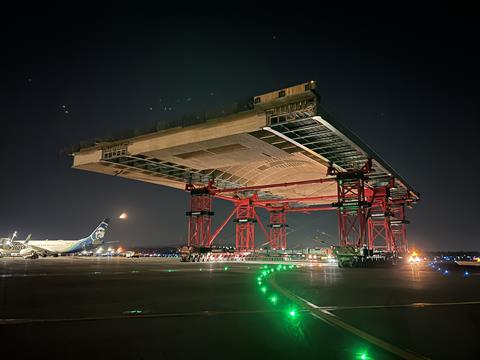Mammoet is supporting Portland International Airport’s (PDX) main terminal expansion project. The heavy lift specialist is on hand to jack up, transport and install 20 roof panels all while avoiding passenger disruption.

The expansion at PDX will nearly double the size of its main terminal. A key component for that expansion is the isolated roof structure over the central area of the airport. The roof, crafted mainly from regionally and sustainably sourced wood, has been fully prefabricated between the active runways of the airport over the course of a year.
To date, Mammoet has placed 16 panels to wrap up phase one of the project. Four additional panels will be installed in 2024 during phase two.
Prior to being moved, roof panels were disconnected into pieces to be transported. Dimensions measured up to 72 m x 50 m x 6 m, while weights varied between 40 tonnes and 632 tonnes.
This allowed the airport to carry-on as usual while minimising disruption to airport operations, said Mammoet. Depending on the type of panel, they are launched, rolled into place, set directly with SPMTs or lifted with a crane into its final position.
Mammoet used four towers of its Mega Jack 800 to jack up the roof panels to approximately 17 m to allow SPMTs to be driven underneath each section. At midnight on the day of each move, the runways were closed for the one-mile (1.6 km) transport of the panel from laydown yard to terminal.
Most panels needed to be installed over the top of populated areas of the existing terminal building. As such, work was completed during overnight closures. Once the area was verified to be clear of all pedestrians, the installation of the roof panels could begin.
Panels were installed using stationary skidding, propelled by strand jacks and lowered with the skidding jacks onto column isolators. The next set of panels were then rolled into position down the bottom flanges of the previously set panels.
A major complexity of the project was the wood material used in the roof panels’ construction, Mammoet explained. Deflection of the roof panels was a concern of the client and the roof designers, so at each point in the jacking, transport, and installation process deflection of the roof was monitored and kept within stringent criteria.
















